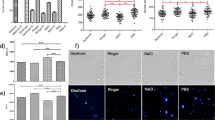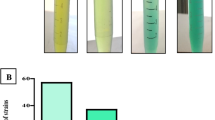Abstract
In previous studies, we detected the photoinitiators 1-hydroxycyclohexyl phenyl ketone (1-HCHPK) and 2-methyl-4'-(methylthio)-2-morpholinopropiophenone (MTMP) in an intravenous injection solution. Importantly, 1-HCHPK and MTMP have been demonstrated to be cytotoxic to normal human peripheral blood (PB) mononuclear cells (MNC). Cell death (apoptosis) pathways can be classified into two modes, caspase-dependent and -independent pathways. However, it is unclear whether methyl 2-benzoylbenzoate (MBB) induces the caspase-dependent and/or -independent pathway in normal human PBMNC. In the present in vitro study, we examined the levels of MBB in a solution from an intravenous fluid bag and the cytotoxicity of MBB towards normal human PBMNC via the caspase-8-, caspase-9-, or apoptosis-inducing factor (AIF)-mediated apoptosis pathways. We found that extracts from the injection solution had been contaminated with approximately 80 μM of the photoinitiator MBB. In addition, MBB induced apoptosis in the high concentration range in normal human PBMNC in vitro. Moreover, we found that MBB-induced apoptosis occurs via the caspase-9 pathway, but not the AIF pathway. In conclusion, we suggest that MBB has cytotoxic effects on normal human PBMNC in vitro, which are mediated via the caspase-dependent pathway.






Similar content being viewed by others
References
Aparicio JL, Elizalde M (2015) Migration of photoinitiators in food packaging: a review. Packg Technol Sci 28:181–203
Chatila TA (2005) Role of regulatory T cells in human diseases. J Allergy Clin Immunol 116:949–959
Earnshaw WC, Martins LM, Kaufmann SH (1999) Mammalian caspases: structure, activation, substrates and functions during apoptosis. Annu Rev Biochem 68:383–424
Eick JD, Kostoryz EL, Rozzi SM, Jacobs DW, Oxman JD, Chappelow CC, Glaros AG, Yourtee DM (2002) In vitro biocompatibility of oxirane/polyol dental composites with promising physical properties. Dent Mater 18:413–421
Elmore S (2007) Apoptosis: a review of programmed cell death. Toxicol Pathol 35:495–516
Fedorovich NE, Oudshoorn MH, van Geemen D, Hennink WE, Alblas J, Dhert WJ (2009) The effect of photopolymerization on stem cells embedded in hydrogels. Biomaterials 30:344–353
Gordon S, Taylor PR (2005) Monocyte and macrophage heterogeneity. Nat Rev Immunol 5:953–964
Kawasaki Y, Yamaji K, Matsunaga H, Sendo T (2012) Cytotoxicity of the polymerization agent, 2-Methyl-4'-(methylthio)-2-morpholinopropiophenone on human monocytes. Biol Pharm Bull 35:256–259
Kawasaki Y, Yagi K, Tsuboi C, Morizane M, Kitamura Y, Sendo T (2013) The polymerization agent, 2-methyl-4'-(methylthio)-2-morpholinopropiophenone induces caspases-3/7 in human blood mononuclear cell in vitro. Biol Pharm Bull 36:1640–1645
Kostoryz EL, Tong PY, Chappelow CC, Eick JD, Glaros AG, Yourtee DM (1999) In vitro cytotoxicity of solid epoxy-based dental resins and their components. Dent Mater 15:363–373
Kruidering M, Evan GI (2000) Caspase-8 in apoptosis: the beginning of “the end” ? IUBMB Life 50:85–90
Li L, Chen GG, Lu YN, Liu Y, Wu KF, Gong XL, Gou ZP, Li MY, Liang NC (2012) Ent-11a-hydroxy-15-oxo-kaur-16-en-19-oic-acid inhibits growth of human lung cancer A549 cells by arresting cell cycle and triggering apoptosis. Chin J Cancer Res 24:109–115
Li P, Nijhawan D, Budihardjo I, Srinivasula SM, Ahmad M, Alnemri ES, Wang X (1997) Cytochrome c and dATP-dependent formation of Apaf-1/caspase-9 complex initiates an apoptotic protease cascade. Cell 91:479–489
Li P, Nijhawan D, Wang XD (2004) Mitochondrial activation of apoptosis. Cell 116:S57–S59
Loreto C, La Rocca G, Anzalone R, Caltabiano R, Vespasiani G, Castorina S, Ralph DJ, Cellek S, Musumeci G, Giunta S, Djinovic R, Basic D, Sansalone S (2014) The role of intrinsic pathway in apoptosis activation and progression in Peyronie’s disease. Biomed Res Int. doi:10.1155/2014/616149
Momo F, Fabris S, Stevanato R (2007) Interaction of isopropylthioxanthone with phospholipid liposomes. Biophys Chem 127:36-40
Mosmann T (1983) Rapid colorimetric assay for cellular growth and survival: application to proliferation and cytotoxicity assays. J Immunol Meth 65:55–63
Ollila J, Vihinen M (2005) B cells. Int J Biochem Cell Biol 37:518–523
Ravagnan L, Roumier T, Kroemer G (2002) Mitochondria, the killer organelles and their weapons. J. Cell Physiol 192:131–137
Rowinsky EK (2005) Targeted induction of apoptosis in cancer management: the emerging role of tumor necrosis factor-related apoptosis-inducing ligand receptor activating agents. J Clin Oncol 23:9394–9407
Searle J, Kerr JF, Bishop CJ (1982) Necrosis and apoptosis: distinct modes of cell death with fundamentally different significance. Pathol Annu 17:229–259
Sun C, Chan SH, Lu D, Lee HM, Bloodworth BC (2007) Determination of isopropyl-9H-thixanthen-9-one in packaged beverages by solid-phase extraction clean-up and liquid chromatography with tandem mass spectrometry detection. J Chromatogr A 1143:162–167
Susin SA, Lorenzo HK, Zamzami N, Marzo I, Snow BE, Brothers GM, Mangion J, Jacotor E, Costantini P, Loeffler M, Larochette N, Goodlett DR, Aebersold R, Siderovski DP, Penninger JM, Kroemer G (1999) Molecular characterization of mitochondrial apoptosis-inducing factor. Nature 397:441–446
Tamayev R, Akpan N, Arancio O, Troy CM, D’Adamio L (2012) Caspase-9 mediates synaptic plasticity and memory deficits of Danish dementia knock-in mice: caspase-9 inhibition provides therapeutic protection. Mol Neurodegener. doi:10.1186/1750-1326-7-60
Thayyullathil F, Chathoth S, Hago A, Patel M, Galadari S (2008) Rapid reactive oxygen species (ROS) generation induced by curcumin leads to caspase-dependent and -independent apoptosis in L929 cells. Free Radic Biol Med 45:1403–1412
Volk J, Leyhausen G, Wessels M, Geutsen W (2014) Reduced glutathione prevents camphorquinone-induced apoptosis in human oral keratinocytes. Dent Mater 30:215–226
Wolf BB, Green DR (2002) Apoptosis: letting slip the dogs of war. Curr Biol 12:R177–R179
Yamaji K, Kawasaki Y, Yoshitome K, Matsunaga H, Sendo T (2012) Quantitation and human monocyte cytotoxicity of the polymerization agent 1-Hydroxycyclohexyl Phenyl Ketone (Irgacure 184) from three brands of aqueous injection solution. Biol Pharm Bull 35:1821–1825
Zheng TS, Schlosser SF, Dao T, Hingorani R, Crispe IN, Boyer JL, Flavell RA (1998) Caspase-3 controls both cytoplasmic and nuclear eventsassociated with Fas-mediated apoptosis in vitro. Proc Natl Acad Sci U S A 95:13618–13623
Zimmermann KC, Green DR (2001) How cells die: apoptosis pathways. J Allergy Clin Immunol 108:S99–S103
Author information
Authors and Affiliations
Corresponding author
Ethics declarations
Conflict of interest
There are no conflicts of interests related to this study.
Additional information
Responsible editor: Philippe Garrigues
Rights and permissions
About this article
Cite this article
Tsuboi, C., Kawasaki, Y., Yoshitome, K. et al. In vitro quantitative determination of the concentration of the polymerization agent methyl 2-benzoylbenzoate in intravenous injection solution and the cytotoxic effects of the chemical on normal human peripheral blood mononuclear cells. Environ Sci Pollut Res 23, 10262–10269 (2016). https://doi.org/10.1007/s11356-016-6332-y
Received:
Accepted:
Published:
Issue Date:
DOI: https://doi.org/10.1007/s11356-016-6332-y




